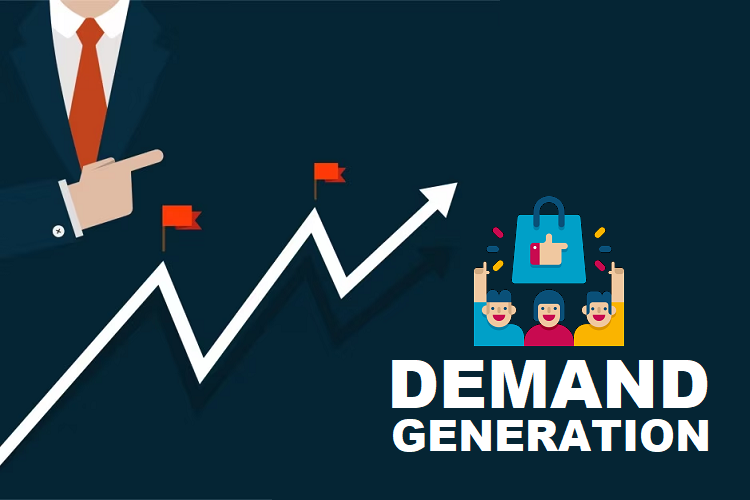Demand generation is a strategic approach that focuses on creating awareness and interest in your products or services to drive customer engagement and ultimately lead to business growth. It’s about generating demand and interest in what your business offers, rather than simply responding to existing demand. Business are using various demand generation strategies and tactics to attract, engage, and convert potential customers. However, no two businesses approach demand generation marketing the same way. If you aren’t sure where to start, you are not alone. This is your inside look at creating demand through inbound marketing.

10 Killer Demand Generation Strategies
Here are some key strategies and components of demand generation for business growth.
1. Respect the Buyer’s Journey
Creating demand for a product or service requires putting yourself in the shoes of a prospective client. Take a moment to ponder the stages of the average buyer’s journey. Demand generation entails the entirety of marketing efforts employed to steer prospects along the buyer’s path to eventual conversion.
The aim is to spur interest in the value offering to the point that targets pay for it today and also in the future. Take a moment to view your company, product/service, and marketing from the viewpoint of a buyer and shape your demand marketing effort accordingly.
2. Social Media

Social media makes it easy to rouse interest in products and services. Though there is the option of placing paid ads on X (formerly known as Twitter) and Meta, all social media platforms provide the option of posting for free. Create business accounts for your enterprise, post at least once every couple of days, and interact with your online audience.
Even something as simple as posting Instagram stories will steer web users toward your homepage and other social media pages, driving demand all the more. Some businesses go as far as encouraging employees to share the company’s social media content on their own pages or even create accounts on online discussion forums to promote the brand, albeit discreetly.
Make a concerted effort to differentiate your value offering from that of the pack when using social media and you’ll succeed in capturing market share through the simple act of sharing online content.
3. Paid Advertising

Some business owners and managers are hesitant to pay for online ads simply because doing so takes a chunk out of the marketing budget. However, paid advertising on social media is quite effective. Target your coveted audience with tailored paid ads placed on social media along with search engines and it won’t take long for members of the online audience to surf their way over to your online footprint.
If your business is primarily business-to-consumer (B2C), you’ll find search engine ads and Meta ads are optimal. Alternatively, business-to-business enterprises (B2B), often find LinkedIn ads are the most effective. Regardless of your approach to paid advertising, employ A/B testing to get a sense of which ads perform the best and move forward accordingly.
Weave in appropriate keywords and key phrases throughout your pay-per-click (PPC) campaigns, ensuring your ads are relevant to what your target audience is most likely to sleuth for when conducting online searches.
4. Content Marketing
Content marketing is a crucial component of demand generation. Effective content marketing can help drive demand for your products or services by building brand awareness, establishing your authority in your industry, and nurturing relationships with potential customers.
Analyzing the performance of your content provides insights into what resonates with your audience. You can use this data to refine your content strategy and optimize your demand generation efforts.
Define your target audience, understand their needs and preferences, and create content that speaks directly to them. High-quality content keeps your audience engaged and coming back for more. Over time, this engagement can translate into increased demand for your products or services.
5. Email Marketing

Email marketing is a powerful tool in demand generation, enabling you to directly communicate with your audience and nurture leads throughout the buyer’s journey. When used effectively, email marketing can drive awareness, engagement, and conversions, ultimately contributing to business growth.
By integrating email marketing into your demand generation strategy, you can create a direct line of communication with potential customers, guide them through their decision-making process, and keep your brand top-of-mind. This ongoing engagement can lead to increased demand and conversions over time.
6. Webinars and Events

Webinars and events are highly effective demand generation strategies that allow you to connect with your audience on a deeper level, showcase your expertise, and drive interest in your products or services. Hosting webinars and events provides a platform for educating, engaging, and nurturing potential customers.
It’s a unique opportunity to showcase your expertise, connect with your audience, and establish a stronger connection between your brand and potential customers. When executed well, these strategies can contribute significantly to demand generation and business growth.
7. Influencer Collaborations
Influencer collaborations can be a powerful strategy for demand generation, as they leverage the credibility, reach, and engaged following of influencers to promote your products or services. Influencers have the ability to introduce your brand to a wider audience and generate interest among their followers.
It offers a unique opportunity to tap into an influencer’s existing audience and generate demand by leveraging their credibility and reach. By carefully selecting influencers, nurturing authentic relationships, and aligning your collaboration with your overall marketing goals, you can drive significant demand and growth for your business.
8. Free Tools
Paid advertising, social media, and SEO are important yet their individual impacts are not guaranteed to be greater than the power of a freebie. Provide your audience with a no-cost tool such as a hashtag generator, a tool for evaluation, or an eBook.
Even a small free sample of your value offering will go a long way in proving that your solution is highly effective at addressing pain points. Additional examples of freebies to drive demand include free reports, microphone/webcam testers, and image-resizing tools for social media.
9. Contact Segmentation
Contact segmentation makes it that much easier to optimize your demand generation campaign. The challenge lies in transmitting the optimal message to the target audience in a cost-efficient manner. Separate customers into specific contact groups based on their respective progression in the buyer journey.
Now that the contacts are properly segmented, it is time to target campaigns to those specific groups, providing content that each is most likely to appreciate. Such segmentation ensures the message resonates with the target audience, maximizing the chances that they’ll be receptive to additional messages and also pay their hard-earned money for the value proposition.
Segmenting the audience also facilitates the accurate measurement of demand generation campaign performance, providing a golden opportunity to make strategic adjustments that appeal to each individual cohort of target customers.
10. Make Target Prospects Feel Valuable
Listen closely when prospects and current customers provide feedback about your demand generation marketing. Some such feedback will be unsolicited. However, if there is minimal or no feedback, it is in your interest to be proactive and request the thoughts of prospects and current customers.
Pay close attention to customer responses and you’ll have a better idea of which demand generation efforts make a lasting impact and which are quickly forgotten. Implement the necessary changes and your ensuing demand generation marketing efforts will make a much more powerful impact when presented to audiences in the months ahead.
Conclusion
Demand generation is a long-term strategy that aims to build a steady stream of interested and engaged potential customers. By effectively implementing these demand generation strategies, you can create a strong foundation for sustained business growth over time.
A successful demand generation strategy combines these tactics in a coordinated and cohesive manner to create a steady flow of interested and engaged potential customers, ultimately driving business growth over time.


